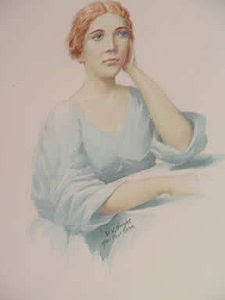Narcissa Prentiss Whitman is, along with her husband, among the most famous pioneers of the nineteenth century.
"Among the first American settlers in the West, the Whitmans played an important role in opening the Oregon Trail and left a tragic legacy that would continue to haunt relations between Whites and Indians for decades after their deaths."
Knowledge of her story begins with her first ancestor to America, Henry Prentice, who emigrated from England prior to 1640 and settled in Cambridge, Massachusetts.
Her parents were Stephen and Clarissa Prentiss to whom she was born in 1808, New York. She was their third child and eldest daughter of nine; and as such, she helped with the upbringing of her younger brothers and sisters.
Stephen Prentiss was by profession a carpenter but became a farmer in order to support his family. Once his hard work paid off and the community began to grow, he started operating a gristmill, distillery, and sawmill, which supplied him with lumber. Before long, he was able to make a living building houses.
At a revival in 1819, young Narcissa Prentiss received Jesus as her Lord and Savior and became a member of the Congregational Church. She attended Prattsburg's Franklin Academy to gain a high-grade education.
Ever busy with household chores and studying, she one day became mesmerized by the biography of a missionary named Harriet Boardman. This is who inspired her to also dedicate her life as a missionary for God when she applied to the American Board of Commissioners for Foreign Missions, the umbrella group for Protestant missions to Indian peoples:
"I frequently desired to go to the heathen but only half-heartedly and it was not till the first Monday of Jan. 1824 that I felt to consecrate myself without reserve to the Missionary work waiting the leadings of Providence concerning me."
Another student, Henry Harmon Spalding, at Franklin College was quite taken with Narcissa and asked her to marry him. Though she turned down his proposal, they remained good friends. He became a missionary and later married another pious woman named Eliza. He and Eliza were to later accompany the Whitmans to the Oregon Country.
Narcissa was attracted to Marcus Whitman, a man six years her senior and who was born in the small town of Rushville, New York. He studied under a local doctor and received his degree from medical college in 1832. After practicing medicine for four years in Canada, he returned to New York and became an elder of the Presbyterian church. In 1835 he journeyed to the Oregon territory to inspect its potential as a mission site.
The next year the Whitmans and Spaldings set foot for Oregon with some fur traders and a prospective missionary named William H. Gray. This arduous expedition marked a number of firsts, creating the first journey to have travelled that far West and the first white women to cross the Rocky Mountains. Their adventure opened the way for later generations of women to cross the continent over land.
The Whitmans reached the Walla Walla river in the fall of 1836 and founded a mission to the Cayuse Indians in the Walla Walla Valley. The Spaldings founded a mission to the Nez Percé in present day Idaho.
Narcissa and Marcus worked hard and happily in befriending Indians and telling them about the gospel. They constructed several buildings where they held church services, taught classes, and practiced medicine. Narcissa wrote back home, "We never had greater encouragement about the Indians than at the present time."
In 1837, Narcissa gave birth to Alice Clarissa, "a treasure invaluable," the first child born of American parents in the Oregon Country, and for a while Narcissa's contentment was complete.
The Indians seemed to be fascinated by the little white baby,
"Her whole appearance is so new to them. ... her size and dress, ... all excite a deal of wonder; for they never raise a child here except they are lashed tight to a board, and the girls' heads undergo the flattening process."
Narcissa was always busy as a hostess to the Indians and to new settlers. She was gentle and untiring, bursting with happiness and pride until tragedy struck at the heart of her world. Two-year-old Alice had drowned in the nearby Walla Walla river, her body later found by the river side.
"But she had gone; yes, and because my Saviour would have it so. He saw it necessary to afflict us, and has taken her away."
Narcissa drew closer to God, seeking Him for strength to carry on with her mission. Though she never gave up in trying to convert the natives, her heart was empty. She grew weak and feeble, her eyesight almost to the point of blindness, and she missed her family. To top it off, the Cayuse were unreceptive to their preaching of the gospel. There were times when she felt weary and irritable over her workload and over the hygiene of the Indians who came to her house.
"They are so filthy they make a great deal of cleaning wherever they go, and this wears out a woman very fast. We must clean after them, for we have come to elevate them and not to suffer ourselves to sink down to their standard."
Throughout her grief and mourning, Narcissa remained helpful, taking in children, no less than 11, who had lost their parents, including a Nez Percé girl named Helen Mar Meek, whose mother had abandoned her and an Indian/Spanish boy they named David.
"They were an afflicted and distressed family in the journey, and when the children arrived here they were in a miserable condition." The children "rolled a burden upon me insupportable. Nothing could reconcile me to it but the thought that it was the Lord that brought them here, and He would give me grace and strength."She made rag dolls for the girls, often took long walks in search of flowers to brighten the home, taught school on a regular basis, held prayer meetings, and strictly observed the Sabbath. She spoke affectionately of her husband who assisted her always. Yet their efforts did little to convert the natives.
The American Missionary Board decided to close the mission in 1842 and transfer the Whitmans elsewhere. Marcus went back East and was able to convince the Board that there was much work to do where they were and that he wanted to return. On the way back, he lead a wagon train of one thousand pioneers up the Oregon trail.
The new settlers needed assistance from the Whitmans and took away time which had previously been used in ministering to the Cayuse. The Indians felt alienated, neglected, and suspicious, as Narcissa relates:
In 1847, during an unusually cold winter, an epidemic of measles struck the area. The Whitmans worked to save all humankind in the vicinity. Most of the white children lived while about half of the Cayuse, including nearly all their children, died.
"the poor Indians are amazed at the overwhelming numbers of Americans coming into the country... They seem not to know what to make of it."
According to available records, a half-breed called Jo Lewis told the natives that the Indians were being poisoned by the doctor so that the Whites could take over the country for themselves. A loyal Indian called Stickas ran to tell Mr. Whitman of her lies, but his warning came too late.
On November 29, 1847, Chief Tiloukaikt lead several Cayuse on a revenge massacre. They killed fourteen Whites, including the Whitmans. Survivors were taken captive, and mission buildings were burned down. For this act, a band of White people attacked the Cayuse who were no match for them.
Already weakened by disease, the Cayuse joined the nearby Nez Percé and Yakima tribes, as they tried to fight for their survival. A war would have continued, but Tiloukaikt and others gave themselves up in hopes of letting others of the tribe live on, explaining, "Did not your missionaries teach us that Christ died to save his people? So we die to save our people."
The memory of the Whitmans is still alive because of Narcissa's many letters to her family. Her home near Walla Walla, Washington, as well as her first home in Prattsburg, New York, have been preserved. Whitman Mission is located in SE Washington, 7 miles west of Walla Walla, just off Hwy. 12. (Photo of Whitman Mission, above right, by Regent-Carla Rigby of Yakima DAR.)
See: Diaries and journals of Narcissa Whitman. Clash of cultures.
Drury, Clifford Merrill 1897. Marcus and Narcissa Whitman and the Opening of Old Oregon, Drury. Seattle, WA: Pacific Northwest National Parks & Forest Association; 1986;2 v. : ill., maps ; 22 cm. ISBN: 0914019082
The Legend of Singing River
Choctaw Indian legend
The Singing River in Pascagoula, Mississippi, is known for the murmuring noise it makes. It sounds like a swarm of bees which grows ever louder until it seems to come from under foot. Science tries to explain this phenomenon but cannot prove any possible theories. Some believe it is the mysterious death song of the Pascagoula Indian tribe.
The Pascagoula Indians were a peaceful tribe that the Biloxi Indians resented for encroaching on their territory. To the Biloxi dismay, their Princess Anola fell in love with Altama, Chief of the Pascagoulas. She excaped the Biloxi to be with him.
Enraged, the spurned Biloxi vowed punishment on the outnumbered Pascagoulas. The Pascagoulas could not save Altama and his bride so they swore to die with them. Joining hands, they began to chant a song of death as they walked into the mighty flowing river, until "the last voice was hushed by the dark engulfing waters."










































































No comments:
Post a Comment